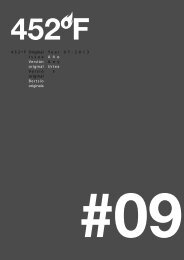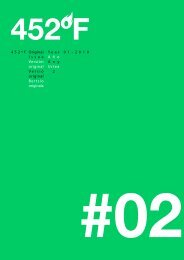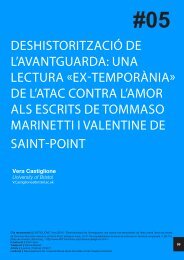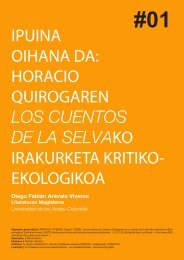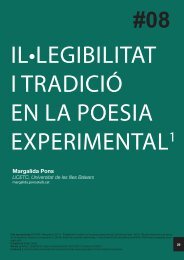03 - 452ºF
03 - 452ºF
03 - 452ºF
Create successful ePaper yourself
Turn your PDF publications into a flip-book with our unique Google optimized e-Paper software.
ead as the setting of their romance. In this case, the Wild West may<br />
simply be construed as a child’s view of the Algerian milieu in the<br />
throes of a violent war—where French soldiers are the ‘cowboys’<br />
and the fellagha are the «Indians». This reading is reinforced by a<br />
passage in the novel in which Lallia comes upon Rachid, who is on<br />
his way to visit the mother of a classmate who was killed:<br />
Ils avaient joué aux militaires et aux fellagha. Comme il était arabe, c’est<br />
lui qui avait joué le fellagha. On dit qu’ils ont fait exprès de le noyer.<br />
Quand on l’a retiré de l’eau il portait la trace des pierres que les autres<br />
lui avaient jetées avant de se sauver<br />
[They were playing at ‘soldiers and fellagha’. Since he was an Arab,<br />
he played the fellagha. People say that they drowned him on purpose.<br />
When they pulled him from the water his body bore traces of the stones<br />
that the others had thrown before escaping] (1983: 160).<br />
The children are killing each other while playing at cowboys and<br />
Indians in a make-believe Wild West with brutal consequences.<br />
The plotline of forbidden love—albeit an awkward love between<br />
children—thus provides another foreign intertext to consider. By<br />
reconfiguring a well-known Shakespearean tragedy Lachmet<br />
transforms its meaning; subtracting key characters and embellishing<br />
others of lesser consequence or adding characters not at all present<br />
in the original text. For example, it is clear that Lallia is our Juliet<br />
while René is Romeo. However, we might read the feuding Capulet<br />
and Montegue families in a more general sense—as represented<br />
by the warring parties of the Algerian Revolution. The deletion of<br />
familiar characters thus provides the opportunity for the construction<br />
of others; it is in this twofold process that we might locate the author’s<br />
intertextual critique.<br />
Lallia sees the Cowboy once more towards the end of the novel<br />
on the day she finds the butcher murdered in the market square.<br />
Leaving the house early one morning to get milk, she discovers she<br />
has made a mistake about the time. All the stores are still closed.<br />
Retracing her steps to return home, she sees a body in the middle of<br />
the church square:<br />
L’homme étendu était mort, le crâne ouvert juste au-dessus du front.<br />
Du sang mêlé à une substance blanche que je me refuse à nommer. Le<br />
corps qui gisait était celui du boucher que je connaissais bien<br />
[The man lying there was dead, his skull open just above the forehead.<br />
Blood mixed with a white substance that I refuse to name. The body was<br />
that of the butcher who I know well] (1983: 163).<br />
Standing frozen to the spot, Lallia contemplates the body. While the<br />
town awakens and gathers around her to look, she imagines she<br />
is all alone and invisible: «J’avais l’impression d’être au fond d’un<br />
puits. Personne ne s’était rendu compte de ma présence. J’étais<br />
transformée en statue invisible, une heure, peut-être plus» [I feel<br />
«Je suis un cowboy du Far West»: A study of textual métissage in Djanet Lachmet’s autobiographical novel Le Cow-boy (1983) - Caroline Kelley<br />
<strong>452ºF</strong>. #<strong>03</strong> (2010) 85-101.<br />
98



